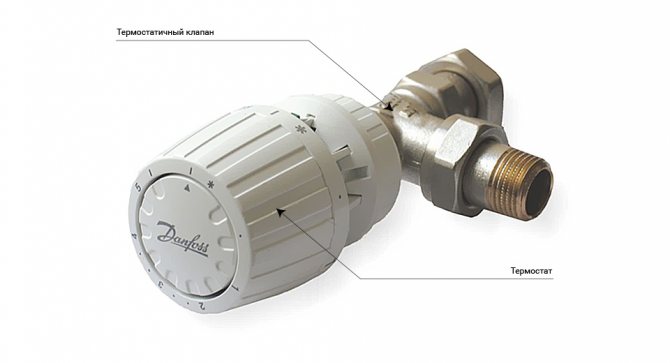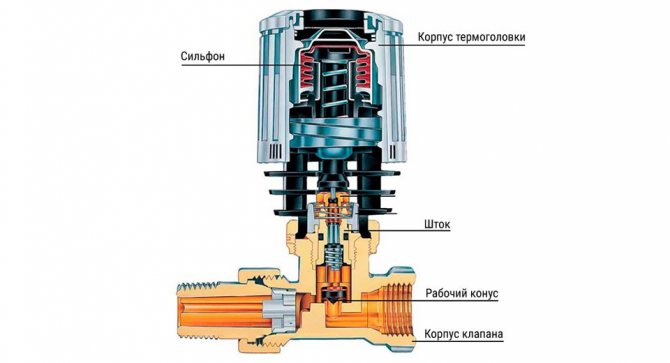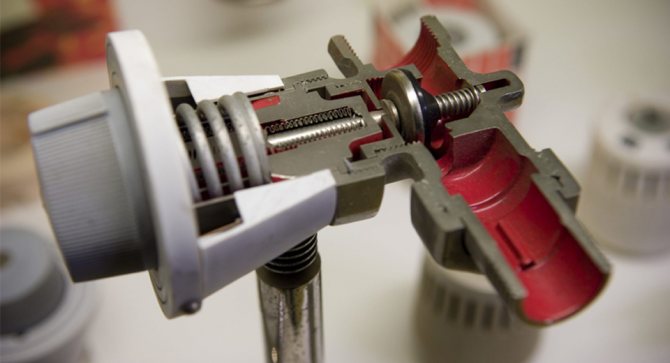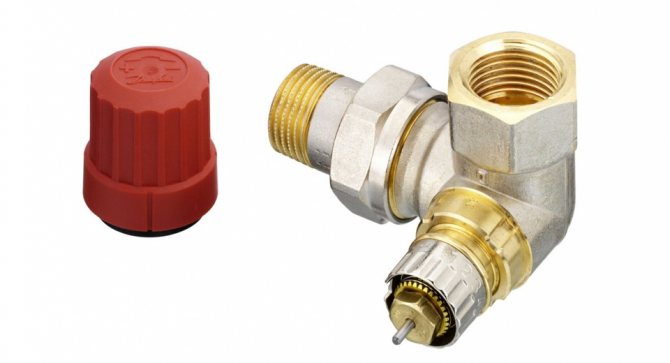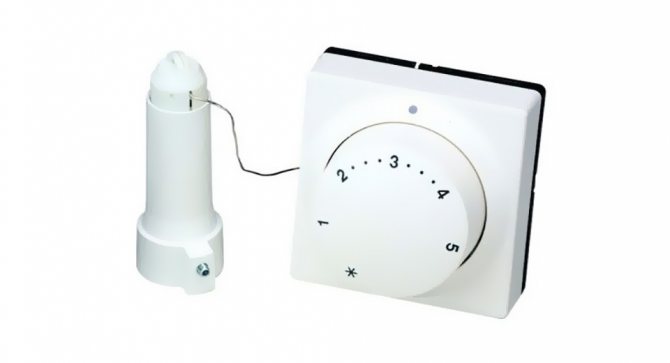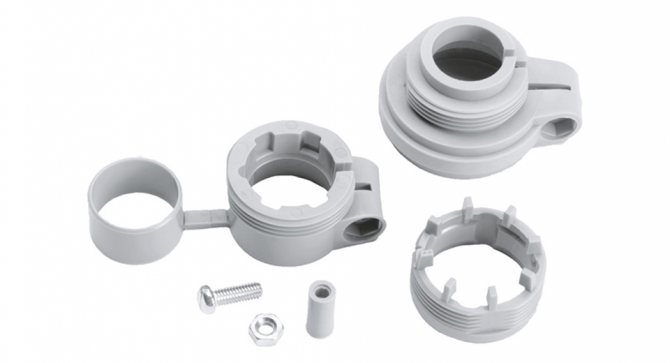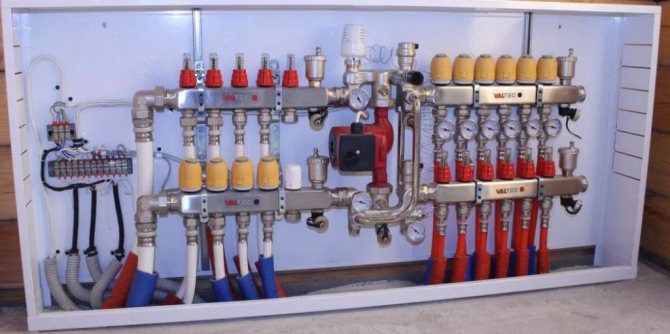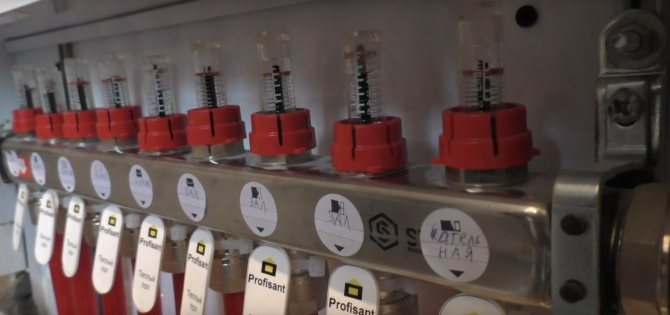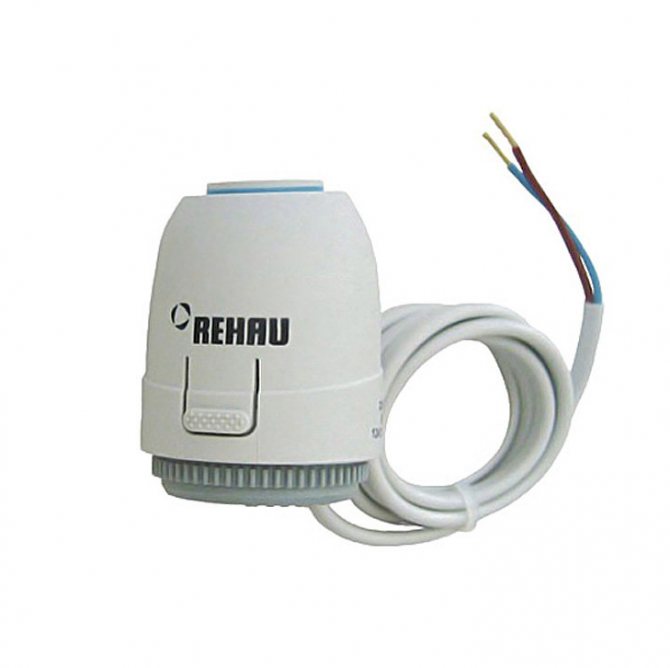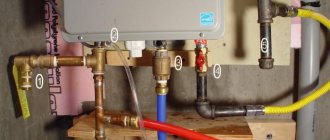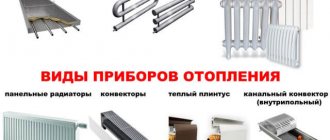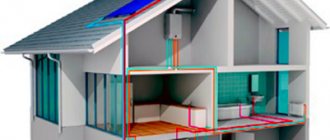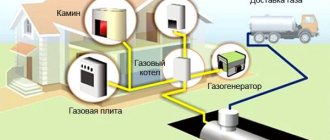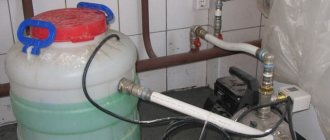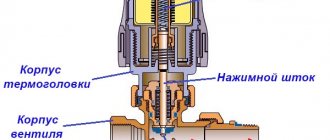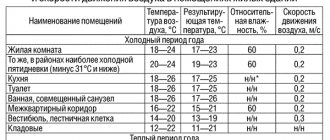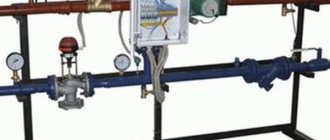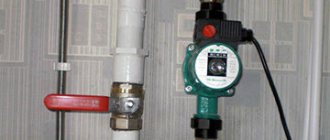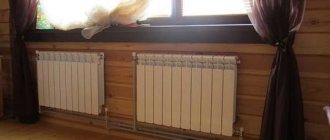The principle of operation of room thermostats
Thermostats with temperature sensor
The room temperature controller works as follows:
- A sensor built-in or removed from the thermostat housing measures the air temperature in the room;
- The sensor transmits information to the actuator;
- The actuator, depending on the temperature value, turns on or off the heating devices and air conditioners connected to the regulator;
- When the room temperature drops to the value that was taken as the minimum during the device settings, the device turns on the heater again.
Thus, this control equipment does not function constantly, but cyclically, turning on and off the heating at the minimum and maximum value of the air temperature in the room. For electromechanical and mechanical thermostats, this range is very small, while for electronic models it can be much wider.
How to install correctly
They put a thermostat for a heating radiator at the inlet or outlet of the heater - there is no difference, they work with equal success in both positions. How to choose a place to install?
At the recommended installation height. There is such a point in the technical specifications. Each device is factory set - calibrated to control the temperature at a specific height and usually this is the top manifold of the radiator. In this case, the heat regulator is installed at a height of 60-80 cm, it is convenient to adjust it manually if necessary.
If you have a bottom saddle connection (pipes fit only from the bottom), there are three options - look for a device that can be installed at the bottom, put a model with an external sensor, or reconfigure the thermal head. The procedure is simple, the description should be in the passport. All you need is to have a thermometer and turn the head at certain moments in one direction, then in the other direction.
The installation process itself is standard. The valve has a thread. Suitable fittings are selected for it or a counter thread is cut on a metal pipe.
One important point to keep in mind for those who want to install a thermostat for a heating radiator in apartment buildings. If you have one-pipe wiring, they can only be installed if there is a bypass - a section of pipe that stands in front of the battery and connects two pipes together.
Otherwise, you will regulate the entire riser, which your neighbors will definitely not like. For such a violation, a very substantial fine can be written out. Therefore, it is better to put a bypass (if not).
Varieties of thermostats
Programmable thermostat W1209
Depending on the design and principle of operation, these devices are of three types: electronic, electromechanical and mechanical.
Electronic
The simplest electronic thermostat is a device consisting of the following parts:
- The controller is a printed circuit board with a microcircuit. This is the key part of the thermostat that receives information from the external temperature sensor, processes it and sends the appropriate signal to turn on or off the heater, air conditioner;
- Monochrome liquid crystal display and control buttons - used for setting and programming the thermostat to maintain the required temperature background in the room;
- Remote temperature sensor connected to the controller using a flexible thin cable;
- Contact group - clamps in which the conductors of the cable connecting the thermostat with a heater or air conditioner are fixed.
Such a device works quite simply: an analog signal arrives from the sensor via a cable to the controller, which is decoded by its microcircuit, correlates with the set temperature value, after which the controller decides to turn on or off the heating equipment.
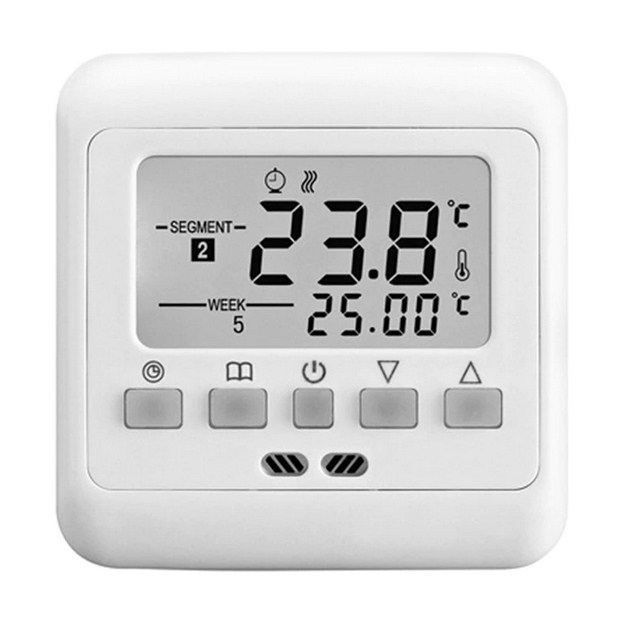
Electronic thermostat
Electromechanical
Occupying an intermediate position between electronic and mechanical such thermostats are of two types:
- With a bimetallic plate and a contact group - a plate is located inside such regulators, which, when heated to a certain level, bends, opening the circuit contacts that feed the heating equipment. When cooling down, the reverse process takes place: the plate straightens, closes the contacts, and the heater turns on. The adjustment of the inclusion of this device is carried out using a rotating dial with a pusher that changes the distance between the plate and the fixed contacts closed by it.
- With a capillary tube - the design of such a device is the same as that of analogues used in water heaters and boilers.
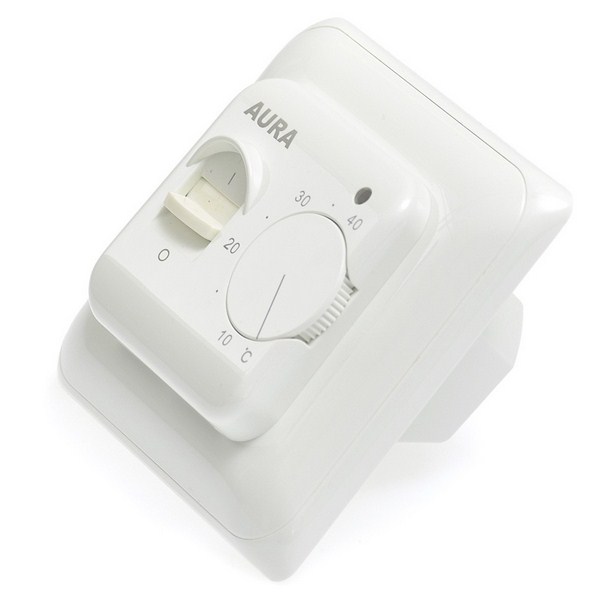
Electromechanical room temperature control
Mechanical
The main elements of this device are a gas-filled membrane that responds to changes in the air temperature in the room, and a control mechanism consisting of two moving contacts.
The thermostat works as follows:
- As the temperature rises, the gas filling the membrane expands;
- A pusher located on one of the outer walls of the membrane opens the contacts of the control mechanism circuit, thereby disconnecting the heater connected to the device.
Regulation in such a thermostat is due to a rotating dial (wheel) that changes the distance between the membrane and the control mechanism.
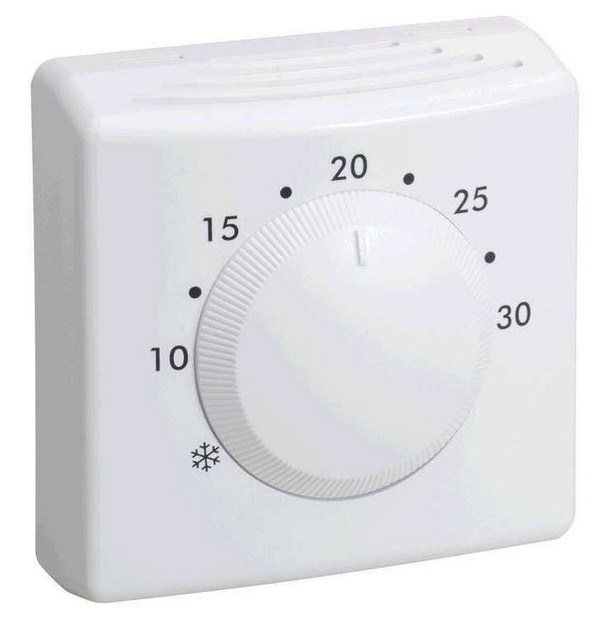

Mechanical type thermostat
Adjusting the temperature of the water heated floor separately by room
In the case when you are just planning to make heating in a house with a water-heated floor, you can organize separate temperature control for rooms.
To do this, it is necessary to design the laying of the contours of the warm floor zoned. Those. the water floor pipe should only be laid in one room. If the area of the room is more than 12 sq. m. two or three pipe circuits should be laid.
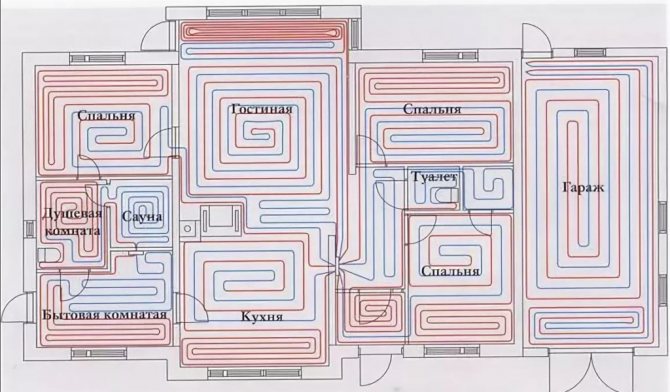

In this case, the mixing unit will be common, the temperature of the coolant will also be controlled for the entire collector at the same time. Those. in the entire underfloor heating system, the temperature will be set by the mixing unit and will not differ.
How to make the control of a warm floor water with several circuits? To do this, we will need to purchase "normally open" servos (desirable but not required). One for each path we are going to control.
Install a temperature sensor (thermostat) in each room. Both wired and wireless options are available. The functionality can also be different. From simple mechanical on / off. Up to complex temperature control by time of day and night. The cost will vary.
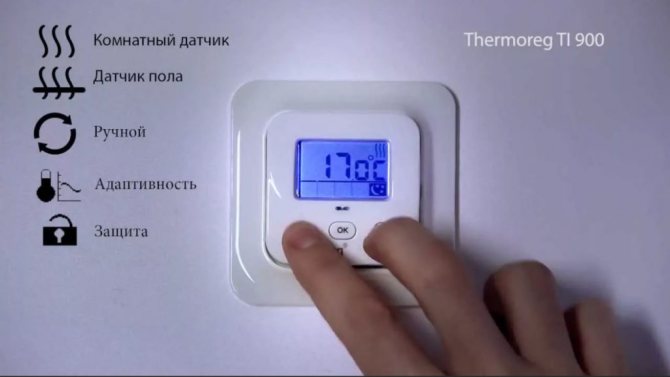

Wired room temperature control
If the temperature sensors are wired, then it will be necessary to lay three-core wires from them to the collector. In this case, the control will go directly to the servo and no additional controller is required.
Wireless temperature control TP
If the temperature sensors are wireless, then no communications are required anymore.Such a decision will be relevant if the repair has already been completed and you want to control the temperature of the water-heated floor at the end of the repair.
In this case, the automation will be located in the immediate vicinity of the temperature control unit and actuate the servos. And from the sensors, the signal about switching on and / or off will only be transmitted to the automation controller. And the controller, in turn, will supply or remove voltage from the drive.
Boiler control
The principle of operation of the thermostat
A gas boiler or electric boiler can be controlled by a thermostat installed in the living room, as well as a more complex temperature background regulator - a programmer. Depending on the boiler design, there are three options for connecting such control devices:
- To special connectors on the boiler control board (for wall-mounted volatile models);
- In series with a boiler thermostat with a mandatory connection to a gas valve (for non-volatile floor-standing models);
- Instead of a boiler thermostat (for floor-standing boilers).
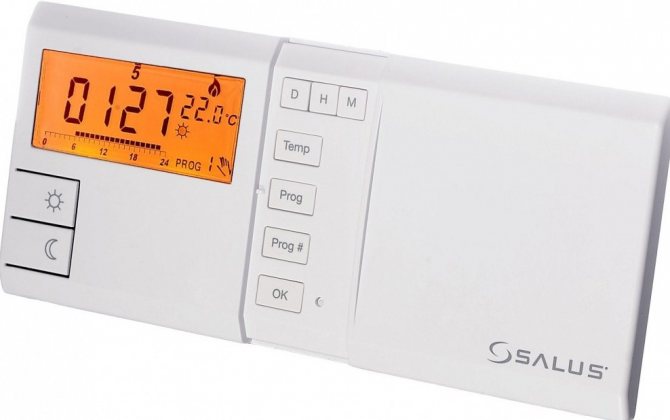

Modern wired programmer for gas boiler
Important! For the installation of such regulators, the most distant rooms from the boiler are chosen: the bedroom, the hall.
Refrigerator temperature sensor location
The location of the regulator depends on the refrigerator model. Information about its structure and location is contained in the operating instructions for the household appliance. It is usually located next to the temperature setting knob. In old household appliances, the thermostat is installed inside the chamber, under the light bulb, and covered with a protective case. To remove the part, the handle is removed by pulling it towards you. Then the screws are unscrewed and the case is dismantled.
In modern models, the thermostat is located outside, usually above the door. If you need to get it, first also remove the adjustment knob. Then the bolts are unscrewed and the panel with the light bulb is removed, after which the regulator is removed.
Installation and connection
Installation of a room temperature controller is carried out in several stages:
- Mounting the regulator on the wall at a height of 150-160 cm away from heating radiators, various heaters, places that are exposed to direct sunlight;
- Connection to the contact group of the cable regulator - the bare and preferably soldered ends of the cable are inserted into special connectors and fixed with screws;
- Laying the cable from the thermostat to the heating equipment in plastic cable ducts;
- Connecting the cable to the corresponding terminals on the boiler control board, the three-way valve actuator on the radiator.
Advantages of using a thermostat
The main advantages of temperature controllers are:
- The ability to maintain a comfortable temperature background in the living room;
- Saving energy carriers used for various types of heating equipment: gas or electricity;
- Increasing the service life of heating equipment - the use of a thermostat significantly reduces the time for switching on and operating the boiler, which extends its service life;
- Low cost and high return on investment;
- Easy to install and use.
Thus, room temperature controllers are very simple, convenient and reliable devices. Maintaining a comfortable temperature background in living quarters, they allow not only to significantly save gas, electricity, but also increase the service life of expensive boilers and other heating equipment.

